A look into Japanese Shinto Shrines
As some of you may remember I started this blog briefly by speaking about my interest in Japan. So, I wanted to close my blog by touching on one of my favorite things about Japan, its shrines and the elements housed within. I have chosen three shrines to look over and discuss with you this time, and I have chosen these three as they were some of the favorites I visited during my brief stay in Japan.
Itsukushima Taisha
Built: estimated at 593 CE
Architect: Unknown
Style: Shinden-zukiri
Location: Miyajima (aka Itsukushima), Japan
Painting:
Illumination of Lotus Sutra
Artist: Anonymnous
Donated to shrine in 1164 CE (creation date unknown)
Location: Japan
Images hosted by: https://en.wikipedia.org/
Overview map hosted by: https://www.miyajima.or.jp/
The first shrine I want to look at is called Itsukushima Taisha. It is believed to have been built in 593 CE, and expanded upon by Taira-no-Kiyomori in 1168 CE. The layout of the shrine was built using the Shinden-zukuri style of the Heian period (794-1185 CE). This particular style focused on lines. The Honden (main shrine) was connected to surrounding buildings by straight, linear corridors. The structures use the Kiritsuma-ryonagare style, a variation of Kasuga- zukiri. This refers to the dual-sloping roof, the ornamental pillars, and using the colors red for the supporting structures and white for the wooden planks. This style has helped the buildings stand out against the environment and surrounding residences. One of my favorite pieces of these shrines is the pillars. They create a lovely pattern between the roof and fencing. There are also the three hexagons bordering a floral image. This is called a Mon and is an identifier for families, individuals, or in this case buildings. While it may be impossible to see this image on the structure from these images you find this pattern on lanterns (stone, brass, or paper) throughout the grounds, noren (fabric curtains) hanging from windows or doorways, and always on the outward faces of the beam placed on top of the gabled roof.
Like all Shinto shrines, this shrine was built to house a deity believed sacred by the residents. This particular shrine was created for the daughters of Susano-o no Mikoto: Ichikishimahime no mikoto, Tagorihime no mikoto, and Tagitsuhime no mikoto. These goddesses are said to reign over the seas and storms. As most of the locals are fishermen that rely on the sea for their living you can imagine how important this shrine is and why it must remain pure and sacred to ensure stability for their livelihood. To prevent this sacred land from being tainted pregnant women are to retreat to the mainland as their delivery date approaches.
Now the beautiful architecture is not the only piece of artwork you would find in the shrine. Shinto shrines are known for housing countless sutras unique to each shrine. The Illusion of Lotus Sutra is the prologue to one such sutra. Images of a sutra are usually accompanied by handwriting, but I will focus on the image itself. The lines are amazing in this image. Each stroke is precise and delicate and you can see techniques used in Japanese calligraphy present as well. The start of a stroke is heavy and the brush is lifted off the paper, creating a fine tapered line. The easiest place to see this is the tree and its branches in the center of the image. Forms are easily recognizable in this image and the I am blown away by the gradation of the coloring of many of these forms. The ripples in the water go from solid blue lines into speckled spots of blue. As I look at it, it appears as if these lines were made with little coloring on the brush to ensure a solid line is not created.
If you would like to see more images please follow the links 1,2, or 3 in my bibliography as there are many more images as well as info I was unable to fit in the previous paragraphs.
Kasuga Taisha
Built: 768 CE
Architect: Unknown
Style: Kasuga-zukiri
Location: Nara, Japan
Images hosted by: https://en.wikipedia.org/
Stone lantern image hosted by: https://en.japantravel.com/
Overview map hosted by: https://www.kasugataisha.or.jp/
Kasuga Taisha is the next shrine I would like to look at. From the images above I'm sure you can already see some of the same influence as Itsukushima Taisha. Dual sloping roofs, ornamental pillars, and the use of red and white as the primary colors of the Kasuga-zukiri style. Kasuga Taisha was built inside a grove of trees on the holy mountain of Mount Mikasa and established for a deity as well. It is believed that Takemikazuchi rode to Mount Mikasa of Nara, the nation's capital at the time, on the back of a white deer. He journeyed from his original shrine to aid in the prosperity of the nation and for the happiness of its people leading this shrine to be built. This shrine was then influenced by the Tempyo Movement where Buddhism began to influence the country politically and culturally. This led to the expansion of the shrine as well as three other deities to be enshrined here. Takemikazuchi is the god of thunder and a sword god, Futsunushi is a warrior god, Ame no Koyane is a heavenly god (resides in Takamagahara) and founder of the Fujiwara clan, and the final deity is Himegana, the consort of
Kasuga Taisha is also known for the 3000 lanterns present on and outside of the shrine's grounds as well as the first stone lantern of Japan. Lanterns represent a guiding light in the Shinto religion while the stone lantern is a reference to the five elements of Buddhist cosmology. The layout of Kasuga Taisha relies on shape rather than line like that of Itsukushima Taisha. This is probabaly due to the dense setting of the mountains forestry. Shinto belief values nature above all so when these shrines are built in nature they aim to exist within rather than overtake. The lanterns are then hung in row after row throughout the shrine. While some lanterns are different, you can easily see the patterns created on the lanterns themselves as well as how they are hung or set standing throughout the shrine.
More images can be found by following links 4 and 5 in my bibliography.
Fushimi Inari-Taisha
Built: 711 CE
Architect: Unknown
Style: Nagare-zukiri
Location: Kyoto, Japan
Images hosted by: https://en.wikipedia.org/ and https://voyapon.com/
Map image hosted by: http://www.dchamberlinarchitect.com/
Fushimi Inari-Taisha is the head shrine for the deity Inari. As the head shrine, it has larger patronage which allows for the shrine to become grander to convey how much the people love the deity enshrined there. Fushimi Inari-Taisha is home to the goddess Ukanomitama-no-Mikoto. She is the goddess of foxes, fertility, and industry to name a few. Naturally, the more things a deity presides over the larger her group of followers will become. This leads to a monumentally sized shrine to accommodate those parishioners on their pilgrimages. While Fushimi Inari-Taisha does utilize a different style of architecture than the other two shrines, both styles stemmed from the same ancestor. This ancestor style originated from a mountain cult of Shinto worshipers where shrines were built temporarily so they could easily relocate the buildings as the god moved throughout the country. From there both styles evolved into their own. Nagare-zukiri differs mainly in the asymmetrical roof which extends out on the side housing the entrance to the building (second image). The same color scheme of red and white is still present, but here we can see buildings have more intricate carvings displayed on entryways.
Fushimi Inari-Taisha is also very proud of their deity's messenger, the fox. Scattered throughout the shrine's grounds you will find carved foxes in many varieties. You will see many sculptures where the fox is holding an item such as a scroll or gem. I believe this is referring to the fox delivering these items to their intended recipient. There are also foxes carved into decorative fountains as well as used for commercial needs such as souvenirs.
A unique aspect of this shrine is the walkway comprised of Torii. They begin on the main grounds and loops back into the hills. The path leads to three peaks each home to an offering location (eighth image). Each offering location is different from the last and can be seen by following link 6. The torii were initially tightly spaced together almost forming a corridor along the mountain path, but because of the desire to coexist within nature, you will find breaks along the path like those above.
You can also check out link 7 for more images as well.
All three shrines were built in different parts of the country, for different deities, and at different times but all three shrines are easily identified by the commonalities of the styles used. These three shrines were built to exist within nature. One shrine was built as if to float on top of the water, another nestled on the slopes of a holy mountain, and the last resting on the foot of Kyoto's hills. I believe that this and the unique focus of each shrine allowed me to feel relaxed even though I was surrounded by parishioners and tourists whenever I visited them. It was an experience I will not forget.
"Shinden-Zukuri - Wikipedia". En.Wikipedia.Org, 2022, https://en.wikipedia.org/wiki/Shinden-zukuri.
"Kasuga-Zukuri - Wikipedia". En.Wikipedia.Org, 2022, https://en.wikipedia.org/wiki/Kasuga-zukuri.
4) "Kasuga-Taisha - Wikipedia". En.Wikipedia.Org, 2022, https://en.wikipedia.org/wiki/Kasuga-taisha.
5) "About The Shrine | 春日大社". 春日大社, 2022, https://www.kasugataisha.or.jp/en/about_en/.
"Takemikazuchi - Wikipedia". En.Wikipedia.Org, 2022, https://en.wikipedia.org/wiki/Takemikazuchi.
"Ame-No-Koyane - Wikipedia". En.Wikipedia.Org, 2022, https://en.wikipedia.org/wiki/Ame-no-Koyane.
"Ame-No-Koyane - Wikipedia". En.Wikipedia.Org, 2022, https://en.wikipedia.org/wiki/Ame-no-Koyane.
"Nagare-Zukuri - Wikipedia". En.Wikipedia.Org, 2022, https://en.wikipedia.org/wiki/Nagare-zukuri.
"Inari Ōkami - Wikipedia". En.Wikipedia.Org, 2022, https://en.wikipedia.org/wiki/Inari_%C5%8Ckami.
Itsukushima Taisha images credited to:
By redlegsfan21 - Flickr, CC BY-SA 2.0, https://commons.wikimedia.org/w/index.php?curid=38043259
By JohnnyOneSpeed - Own work, CC BY-SA 3.0, https://commons.wikimedia.org/w/index.php?curid=23229278
By Bernard Gagnon - Own work, CC BY-SA 3.0, https://commons.wikimedia.org/w/index.php?curid=4184839
Kasuga Taisha images credited to:
By 663highland - Own work, CC BY 2.5, https://commons.wikimedia.org/w/index.php?curid=6069414
By 663highland - Own work, CC BY 2.5, https://commons.wikimedia.org/w/index.php?curid=6069511
By Degueulasse - Own work, CC BY 3.0, https://commons.wikimedia.org/w/index.php?curid=39940306
By Degueulasse - Own work, CC BY 3.0, https://commons.wikimedia.org/w/index.php?curid=38221034
Fushimi-Inari Taisha images credited to:
By Basile Morin - Own work, CC BY-SA 4.0, https://commons.wikimedia.org/w/index.php?curid=81034484
By Fumihiko Ueno, CC BY 3.0, https://commons.wikimedia.org/w/index.php?curid=53780452

.jpg)



.svg.png)



























Great Post! This was a great way to circle back to the start of this class. I also did my post on Japanese art! I love that all the art you shared has red it in. I noticed that's a very common color in Japanese artwork and architecture. It would be so incredible to see these things in person.
ReplyDelete